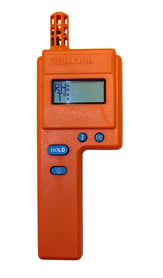For many professionals, knowing the ambient humidity conditions in a given area can be incredibly useful. Some uses of this information include:
- Restoration Experts. Can use relative humidity (RH) measurements to help determine if a building has been sufficiently dried out.
- Flooring Contractors. RH can be used to help determine what the equilibrium moisture content (EMC) of wood flooring should be at the installation site.
- Wood Manufacturers. Can use RH meters to assist with the climate controls in their storage and acclimation facilities to ensure that the moisture content of the wood they ship is close to the client’s requirements.
There are many reasons why different professionals might need to know the relative humidity of a given area beyond the examples above. However, one of the tricky things about measuring RH is that the ambient temperature can play a large role in determining what the RH of a given area is.
This is because the “relative humidity” is the amount of water vapor in the air for a given area expressed as a percentage of the amount needed to reach the “saturation point” at the current temperature (i.e. how much moisture is in the air compared to how much the air can hold before it condenses into water). Because of this, manually measuring RH in especially cold environments can be tough.
Using an RH Meter to Measure Humidity in Cold Environments
 A thermo-hygrometer is a device that can measure both the temperature and the moisture density of a given area and automatically calculate the RH based on that data. The operation for these devices, regardless of the background temperature, is simple: either mount the meter to a surface near the center of the area to be tested, or, for fast-indication meters, simply hold the meter up and push a button to take a reading.
A thermo-hygrometer is a device that can measure both the temperature and the moisture density of a given area and automatically calculate the RH based on that data. The operation for these devices, regardless of the background temperature, is simple: either mount the meter to a surface near the center of the area to be tested, or, for fast-indication meters, simply hold the meter up and push a button to take a reading.
The RH meter will automatically account for the ambient temperature, making measuring RH in hot or cold environments as simple as the push of a button.
Of course, as with any sensitive electronic device, there is a limit to how hot or cold the surrounding environment can be when using the RH meter. Delmhorst’s HT-3000 thermo-hygrometer, for example, has an operating temperature range of -4°F - 158°F (-20°C - 70°C).
Ideally, to maximize the useful life of an RH meter, it should be stored in a sealed container when not in use. Also, if the working conditions are colder than the freezing point of water (0°C or 32°F), the meter should not be left out in the open for long. Prolonged exposure to extremely low temperatures can cause damage to the meter’s sensor element or to the batteries—impacting their power output or allowing condensation to form on the battery terminals.
Need to know more about using a thermo-hygrometer to measure relative humidity in cold environments or other uses for RH meters? Contact Delmhorst Instrument Co. today.

Comments